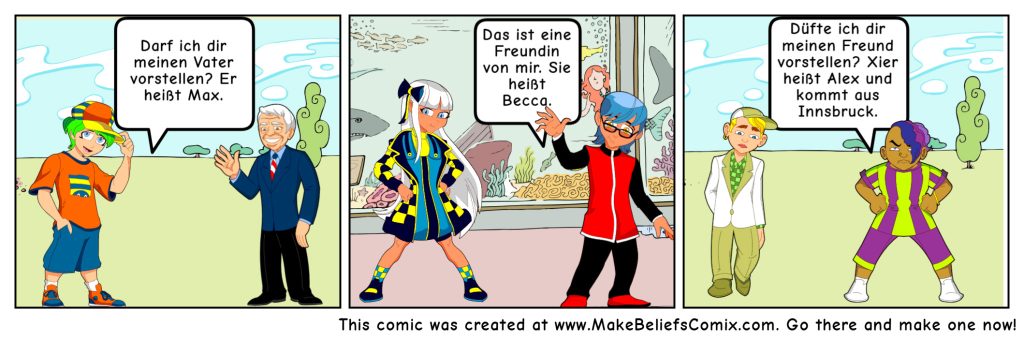1.1 Hallo! Darf ich dir jemanden vorstellen?

Guten Tag!
Let’s warm up with a brief bit of small talk (Tagesminiplausch).
Lektionsüberblick (Lesson overview)
Each lesson will start with a segment called “Was weißt du schon?” (What do you already know?”) that checks whether you have the necessary background knowledge upon which the new lesson will be built. In this first lesson, we are working on introducing family and friends to others. Remember that the focus of this book is on Austria (Österreich), another important German-speaking country, so be on the lookout for tips, tricks, and facts about this country. At the end of this lesson, you will be able to 1) state your intention to introduce someone, 2) introduce that person to another, and 3) say their pronouns. Let’s get started!
Was weißt du schon?
What do you already know? Hopefully, from your previous German language learning experiences, you remember how to say hello, goodbye, nice to meet you, and to say your name. Let’s review those skills. If you are unsure after these exercises, a link is provided to the lessons in the beginning German book, Deutsch im Alltag I.
Read and answer each question (wait a beat after each question for a new question to appear).
| Noch nicht start klar?
Du kannst immer auf die gleiche 1010-Lektion zurückgreifen! |
Not confident about starting this lesson?
You can always review the same Lektion from 1010. |
Österreich im Blickpunkt
1) May I introduce my friend to you?
Look at the comic strip below. Can you tell what the characters are saying or intend to do?
 |
||
If you guessed that they would like to introduce you to friends and family members, you guessed right. Let’s practice. Be sure to click through to each question.
Now let’s look at another way to introduce someone that doesn’t use darf or dürfte. Try reading the sentences in the comic strip below aloud. Then practice with the questions. Be sure to click through to each question.
Jetzt bist du dran!
Österreich im Blickpunkt
 Die Hauptstadt von Österreich heißt Wien. Der Name Wien kommt vom Fluss Wien, der als Wenia erstmals 881 schriftlich erwähnt wurde. Es gibt Städte mit dem Namen Wien in Missouri und Wisconsin. Es gibt Städte mit dem Namen Vienna in 19 amerikanischen Bundesstaaten und in einer kanadischen Provinz.
Die Hauptstadt von Österreich heißt Wien. Der Name Wien kommt vom Fluss Wien, der als Wenia erstmals 881 schriftlich erwähnt wurde. Es gibt Städte mit dem Namen Wien in Missouri und Wisconsin. Es gibt Städte mit dem Namen Vienna in 19 amerikanischen Bundesstaaten und in einer kanadischen Provinz.
The capital of Austria is called Wien (Vienna). The name Wien comes from the river Wien, which was first mentioned as Wenia in 881 in writing. There are cities called Wien in Missouri and Wisconsin. There are cities called Vienna in 19 American states and one Canadian province.
2) Say what another person’s name is
Read and listen to the introductions below.
 |
||
Do you notice the use of er/sie/xier above? These words take the place of the person’s name and are called pronouns.
Let’s practice giving someone’s name using pronouns. Be sure to click through to each question.
Jetzt bist du dran!
Österreich im Blickpunkt
Was bedeutet Innsbruck?
German has many Komposita (compound words). What do you think the Austrian city name of Innsbruck might mean (Think of the words Inn and Brücke), so… “bridge over the inn.” Innsbruck has many Brücken!
3) How to say others’ pronouns
If your family member or friend prefers to have their pronouns stated, here are some common ones:
| His pronouns are he/him. | Seine Pronomen sind er/ihm. |
| Her pronouns are she/her. | Ihre Pronomen sind sie/ihr. |
| Their pronouns are they/them. | Xiere Pronomen sind xier/xiem.* |
*There is no commonly accepted gender-neutral pronoun in German like the singular “they” in English. The grammatically neutral pronoun “es” is not used for people (unless a person chooses to use it for themselves). Instead, there is a large variety of potential gender neutral pronouns. This book will use “xier/xiem”, which has been in use for more than 10 years.
If you want to read more about this topic, you can read comic artist and author Illi Anna Heger’s blog post Pronouns (in English). This webpage (in German) shows the impressive variety of pronoun variations. This video report from 2019 produced by Der Standard discusses this complex topic in Germany.
Jetzt bist du dran!
Zum Schluß
In this lesson, you learned to 1) state your intention to introduce someone, 2) introduce that person to another, and 3) say their pronouns. If you are feeling unsure about any part of the introduction, go back to that section and review.
Now write out your sentence that means you are about to introduce someone, then give that person’s name and any preferred pronouns, if desired. Then record yourself in your audio journal. If you can do it immediately without reading, that’s great! Otherwise, practice saying it a couple times before recording. Or rerecord, if you are not satisfied.

*As you conclude this lesson, don’t forget to check Canvas!*
Österreich im Blickpunkt
What do you think of when you think of Austria? What words come to mind? Let’s hit the streets of Austria to see what Austrians think “typical Austrian” is? You can watch this video. Do you agree or disagree with what you see? Or, perhaps it is all new information for you!

Media Attributions
- 1020 at banner large
- Comic – Darf ich dir einen Freund…made at www.MakeBeliefsComix.com
- 1.1 make-beliefs-comix-39-2048×684
- Private:

